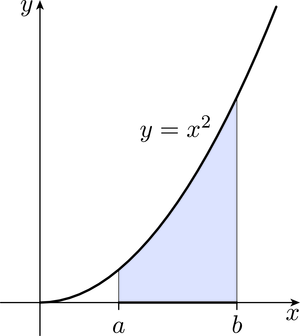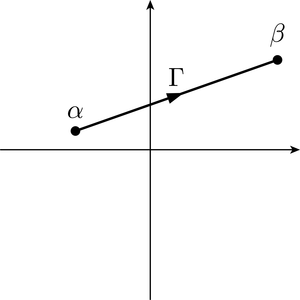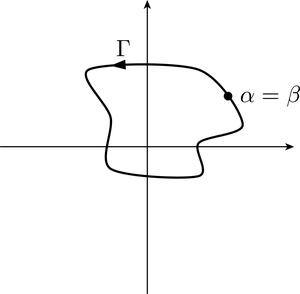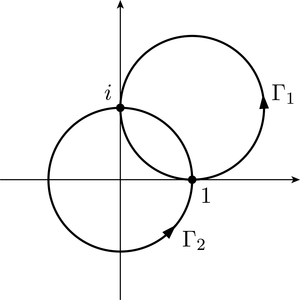Session 2: Integration
Introduction to integration
This session introduces complex integration, an important concept which gives complex analysis its special flavour. We spend most of this session setting up the complex integral, deriving its main properties, and illustrating various techniques for evaluating it.
To define the integral of a complex function, it is instructive to first consider real integrals, such as
where , which represents the area of the shaded part of Figure 1 (for ). We can express this equation in words by saying that
the integral of the function over the interval is .
Suppose now that we wish to integrate the complex function between two points and in the complex plane. To do this, we first need to specify exactly how to get from to . We could, for example, choose the line segment from to , as shown in Figure 2. It turns out (as you will see later) that if we make this choice, then
the integral of the function along the line segment from to is .
We write this as
But there are many other paths in the complex plane from to , which raises the following question. Do we get the same answer if we integrate the function along a different path from to ?
In order to address this question, we first need to explain exactly what it means to ‘integrate a function along a path’. This is one of the objectives of Section 1, where we briefly review the Riemann integral from real analysis, and then use similar ideas to construct the integral of a complex function along a path in the complex plane. We will see that if is a complex function that is continuous on a smooth path in the complex plane, then the integral of along , denoted by , is given by the formula
We can evaluate this integral by splitting into its real and imaginary parts and , and evaluating the resulting pair of real integrals:
Section 2 begins with this definition of the integral of a complex function along a smooth path, and then extends the idea to allow integration along a contour – a finite sequence of smooth paths laid end to end.
In Section 3 we prove the Fundamental Theorem of Calculus, which shows that integration and differentiation are essentially inverse processes. From this result it follows that the integral of along any contour from to is .
We will need to be careful about how we apply results such as the Fundamental Theorem of Calculus. For example, suppose that the endpoints and of coincide, as illustrated in Figure 3. Then
In this case, the integral of the function along is .
Consider now the function . We will see later in Example 4 that if we integrate along the smooth paths and shown in Figure 4, where and are circles traversed once anticlockwise, then
The reason for this difference will become apparent in Section 3.
This OpenLearn course is an extract from the Open University course M337 Complex analysis [Tip: hold Ctrl and click a link to open it in a new tab. (Hide tip)] .




